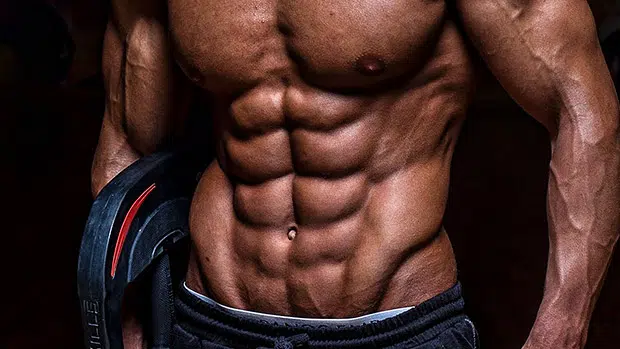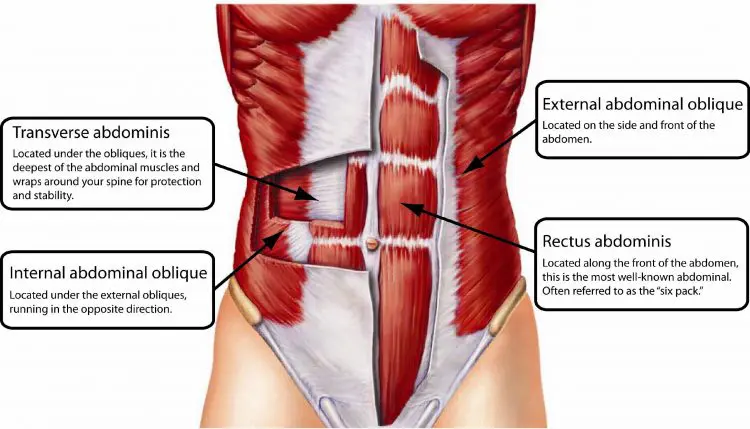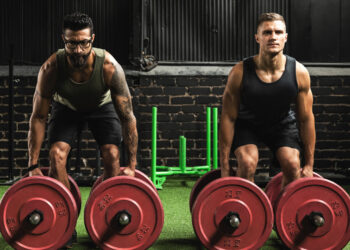A lot of trainers are against direct core exercises. They believe that the best and most time-efficient way to strengthen your midsection is with lots of heavy squats, deadlifts, and overhead presses. However, several studies have shown that muscle activation is significantly higher in exercises like planks than deadlifts, even if you brace like a boss (1).
Long story short, whether you want a six-pack, washboard abs, or just a flatter stomach, direct abs training is a must.

There are LOADS of abs exercises to choose from. And yet, a lot of exercisers are guilty of doing the same old crunches and sit-ups over and over again. Unfortunately, doing these exercises repeatedly means they lose some of their potency, and your workouts will be less productive.
Because of that, if you want to avoid plateaus, you MUST expand your exercise library, so you’ve got plenty of new movements to add to your workouts. That will help keep you out of progress ruts and on track to reaching your training goals.
In this article, we examine the butt up, which, despite its name, is a bodyweight core exercise and not a glute builder. Learn why and how to do butt ups, as well as some cool variations and alternatives.
Level Up Your Fitness: Join our 💪 strong community in Fitness Volt Newsletter. Get daily inspiration, expert-backed workouts, nutrition tips, the latest in strength sports, and the support you need to reach your goals. Subscribe for free!
Butt Ups – Muscles Worked
Butt ups are a simple bodyweight core exercise that emphasizes the muscles on the front of your abdomen and hips.
The main muscles involved in butt ups are:
Rectus abdominis – often known as the abs for short, rectus abdominis is the long, flat muscle on the front of your stomach. While there is no such thing as upper abs or lower abs, doing butt ups does emphasize the fibers at the bottom of your abdominal wall.
The primary function of the rectus abdominis is flexion of your spine, but it also plays a part in lateral flexion and compression of your abdominal contents. When well developed, and you are lean enough, this is the muscle that gives you six-pack abs.
Transverse abdominis – called the TVA for short, this core muscle encircles your midsection like a weightlifting belt. When contracted, the TVA squeezes inward to increase intra-abdominal pressure or IAP. IAP helps stabilize your spine from within. During butt ups, the TVA works to prevent lumbar hyperextension.
Obliques – the obliques are basically your waist muscles. There are two sets of oblique muscles, internal and external, and they’re responsible for lateral flexion and rotation of your spine. During butt ups, the obliques act as stabilizers to prevent unwanted lateral movements.
Hip flexors – unsurprisingly, the hip flexor group of muscles is responsible for hip flexion. During butt ups, they keep your legs elevated. The hips flexors are the iliacus, psoas major, and rectus femoris, which is also one of your quadriceps.
How to Do Butt Ups
Get more from butt ups while keeping your risk of injury to a minimum by following these guidelines:
- Lie on your back. Brace your abs and raise your legs, so they are straight and vertical. Press your lower back into the floor. Put your arms on the floor by your sides for balance. Rest your head on the floor to relax your neck.
- Without using your arms, lift your butt off the floor and push your feet up toward the ceiling. Try to keep your legs vertical, as moving them toward your head will make this exercise easier.
- Without dropping your legs, lower your butt back down to the floor and repeat.
- Increase abs engagement by exhaling forcefully as you lift your butt and inhaling as you lower.
Butt Up Benefits and Drawbacks
Unsure whether butt ups deserve a place in your next core workout? Consider these benefits:
No equipment required – you can do butt ups almost anywhere and anytime because they need no exercise equipment. That’s good news if you prefer to train your core at home rather than in a gym.
Quite challenging – your legs make up about 40% of your body weight. Butt ups involve lifting your legs using just your abs. This means they are considerably harder than exercises involving raising your head and shoulders, e.g., crunches. This makes butt ups a good workout for intermediate and advanced exercisers.
Train your abs and hip flexors together – in nature, your abs and hip flexors usually work together, e.g., when throwing, pushing, kicking, or punching. In contrast, crunches isolate your abs from your hip flexors. Butt ups are arguably more functional.
Minimal setup time – it takes no more than a couple of seconds to get ready for a set of butt ups. This makes them perfect for things like circuit training, HIIT, supersets, and other fast-paced workouts.
Level Up Your Fitness: Join our 💪 strong community in Fitness Volt Newsletter. Get daily inspiration, expert-backed workouts, nutrition tips, the latest in strength sports, and the support you need to reach your goals. Subscribe for free!
While butt ups are a mostly safe and beneficial exercise, there are also a couple of drawbacks to consider:
Back pain – the hip flexor muscles run from your femurs to your lumbar spine. When activated, these powerful muscles can cause hyperextension of your lower back, resulting in lower back pain. That’s why you MUST brace your TVA during this exercise. However, if you can’t maintain lumbar spine stability during butt ups, you may feel this exercise in your back. It could even cause injury.
Easy to cheat – a lot of people make this exercise easier by pushing with their arms. While this will let you lift your butt higher, that extra movement is of little benefit to your abs, which are the target of butt ups. If you can feel your triceps working harder than your core muscles during butt ups, you are cheating and need to dial down the arm involvement.
High flexibility demand – holding your legs straight and vertical requires good hamstring flexibility. If you’ve got tight hamstrings, you may not be able to get into or maintain the correct position to do butt ups.
7 Butt Up Variations and Alternatives
Butt ups are an effective core exercise, but that doesn’t mean you need to do them all the time. There are several butt up variations and alternatives that you can use to keep your midsection workouts productive and interesting:
1. Reverse crunches
Reverse crunches work the same muscles as butt ups, but they are done with bent legs. This creates a shorter lever, making them a more manageable exercise. If butt ups are too hard for you or you struggle to keep your legs straight, this could be a good alternative.
How to do it:
- Lie on the floor with your legs bent and feet raised. Your hips and knees should be flexed to about 90-degrees. Put your arms on the floor by your sides.
- Without using your arms, curl your hips up toward your shoulders, making a C-shape with your spine. Use your abs to lift your hips and not momentum.
- Lower your hips back down and repeat.
- You can also do this exercise by touching your feet on the floor between reps, however, this tends to encourage lumbar hyperextension in some people.
2. Flutter kicks
Flutter kicks are a popular exercise in the military, especially with the Navy SEALs. Unlike butt ups, you don’t actively lift and lower your hips during flutter kicks. Instead, you brace your abs to stabilize your spine while you move your legs. Despite these apparent differences, flutter kicks are just as effective as butt ups.
How to do it:
- Lie on the floor with your legs straight. Put your hands flat on the floor under your butt. Brace your abs.
- Lift your head and shoulders a few inches off the floor and lift your legs by roughly the same amount. Push your lower back into the floor and brace your abs.
- Without letting your lower back arch, kick your feet up and down using an alternating leg action. Four kicks equal one rep.
Read more about flutter kicks, including some great tips, alternatives, and variations, in this in-depth guide.
3. Hanging knee raises
Hanging knee raises work the same muscles as butt ups but don’t require the same degree of hamstring flexibility. You can do this exercise hanging from any suitable overhead bar, such as a tree branch, ceiling joist, pull-up bar, or using a special bench called a captain’s chair.
How to do it:
- Hang with your legs straight and abs braced. Pull your shoulders down and back and look straight ahead.
- Bend your legs and pull your knees up so they are at least level with your hips, and preferably chest height. Tip the bottom of your pelvis forward and up to form a shallow C-shape with your spine.
- Slowly lower your legs and repeat.
- As you get stronger, you can progress to doing this exercise with straight legs.
4. Bicycle crunches
Bicycle crunches work your abs and hip flexors just like butt ups. However, they also involve your obliques, making them a very time-efficient exercise. Avoid neck pain during bicycle crunches but NOT pulling on your head!
How to do it:
- Lie on your back with your legs straight. Place your hands on your temples, brace your abs, and lift your feet a few inches off the floor. Press your lower back into the floor.
- Bend one leg and pull your knee in toward you. Simultaneously, lift your head and shoulders, twist your upper body, and touch your opposite elbow to your bent knee.
- Return to the starting position and repeat on the other side.
- Continue alternating legs for the duration of your set.
- You can also do this exercise with your straight leg resting on the floor, which is considerably easier.
5. Hollow holds
Hollow holds are an isometric core and hip flexor exercise. That means your muscles are fully engaged, but they do not change in length or produce any movement. In short, this is a static exercise.
Your core often has to work statically to prevent unwanted movement of your spine, which means this is a very functional exercise. Also, it’s a lot tougher than it looks!
How to do it:
- Lie on your back and extend your arms overhead, so your biceps are next to your ears. Straighten your legs and point your toes. Press your knees and feet together. Brace your core and contract your rectus abdominis.
- Lift your feet, legs, shoulders, and arms off of the floor and press your lower back into the ground. Your body should resemble a shallow dish, i.e., hollow.
- Hold for just a few seconds and then relax, working up to longer holds as you get stronger.
6. V-ups
V-ups are a challenging bodyweight exercise for your abs and hip flexors. This is a good option if you’ve mastered butt ups or just want to add some variety to your core workouts. Like butt ups, the V-up requires good hamstring flexibility.
How to do it:
- Lie on your back with your legs straight and arms on the floor above your head. Brace your abs and press your lower back into the floor.
- Lift your arms and legs at the same time and reach up toward your toes. Balancing on your butt, your body should resemble a V-shape.
- Lie back down and repeat.
- For an easier workout, try lifting just one leg at a time.
7. Pilates 100
The Pilates 100 is a surprisingly challenging core exercise that, like butt ups, works your abs with your hip flexors. It involves maintaining your core stability for an extended period, making it good for developing better muscular endurance.
How to do it:
- Lie on your back with your legs straight and arms on the floor by your sides. Brace your abs and push your lower back into the floor.
- Lift your head and shoulders off the floor and raise your legs to about 45 degrees.
- Keeping your back flat and your legs up, quickly raise and lower your arms a few inches.
- Continue until you have done 100 reps with your arms, or you cannot keep your lower back flat.
- Make this exercise easier by bending your knees to create a shorter lever. You can also do fewer reps.
Butt Ups – Wrapping Up
Many people believe that, when it comes to strengthening your core, compound exercises like squats and deadlifts are sufficient. And while your core IS involved in compound exercises, EMG studies show that muscle activation is relatively low.
In short, if you want to strengthen your abs, direct core exercises are usually the best option
There are dozens if not hundreds of exercises you can use to develop a stronger midsection, and almost all of them offer at least some benefits.
Butt ups are one of many effective abs exercises and are a worthy addition to your core training workouts. That doesn’t mean there aren’t other similarly effective exercises or that it’s compulsory. However, for hitting your rectus abdominis and hip flexors simultaneously, it’s definitely a good choice.
References:
1 – PubMed: An Electromyographical Comparison of Trunk Muscle Activity During Isometric Trunk and Dynamic Strengthening Exercises (source)
Interested in measuring your progress? Check out our strength standards for Sit Ups, Deadlift, Flutter Kicks, and more.









